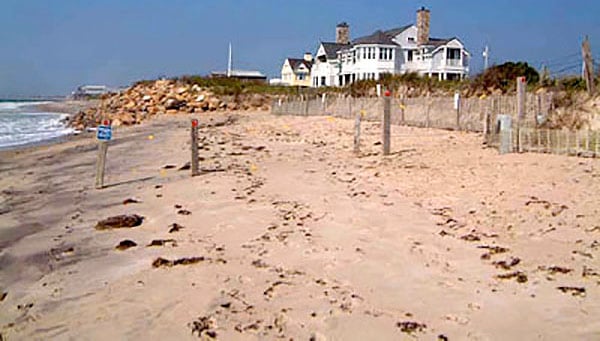SENATE PASSES BILL

WHERE IS THE SHORELINE?
STATE HOUSE — The Senate passed legislation introduced by Sen. Mark McKenney (D-Dist. 30, Warwick) to establish a more practical and recognizable boundary for the area of the shore to which the public is entitled access.
The legislation (2023-S 0417A) sets the line at 10 feet landward from the recognizable high tide line, also known as the “wrack line,” recognizable by a line of seaweed, scum and other deposits left where the tide reached its highest point.
A 1982 state Supreme Court case, State vs. Ibbison, established the boundary of the public’s shore access at the mean high tide line, defined as the average of high tides over an 18.6-year cycle, which continually changes with the shifting sands of the coast.
The Supreme Court’s decision has led to much conflict because it is impossible for anyone walking along the shore to know where that shifting line is.
In recent years, coastal access advocates have pushed for a better solution, including by getting arrested in a contested waterfront area.
The measure now moves to the House, which has passed similar legislation (2023-H 5174) introduced by Rep. Terri Cortvriend (D-Dist. 72, Portsmouth, Middletown).
“The rights of all Rhode Islanders to use the shore are very strong and very old,” said Senator McKenney, who served on a special legislative commission to study shoreline access. “Starting with British common law, through our charter of 1663, all the way to our State Constitution, we have enjoyed the privileges of the shoreline.
Well-intentioned judges in 1982 established that access point as the high-water mark, but that line changed with alarming frequency. This bill will establish once and for all a practicable solution to the question of access and preserve one of the most important rights enjoyed by Rhode Islanders.”
The legislation also exempts owners of shoreline property from liability for the public’s activities in that area, and recognizes that in some waterfront places, such as rocky cliffs and sea walls, there is no passable area for the public to access.
The right of Rhode Islanders to access the shoreline was written into the state constitution when it was adopted in 1843, and further delineated after the 1986 constitutional convention. Yet exactly where the public shoreline ends and private property begins has been a debated issue that has intensified with development of the shoreline over the last century.
A 1982 state Supreme Court case, State vs. Ibbison, established the boundary of the public’s shore access at the mean high tide line, defined as the average of high tides over an 18.6-year cycle, which continually changes with the shifting sands of the coast. The Supreme Court’s decision has led to much conflict because it is impossible for anyone walking along the shore to know where that shifting line is.
In recent years, coastal access advocates have pushed for a better solution, including by getting arrested in a contested waterfront area.
The measure now moves to the House, which has passed similar legislation (2023-H 5174) introduced by Rep. Terri Cortvriend (D-Dist. 72, Portsmouth, Middletown).
